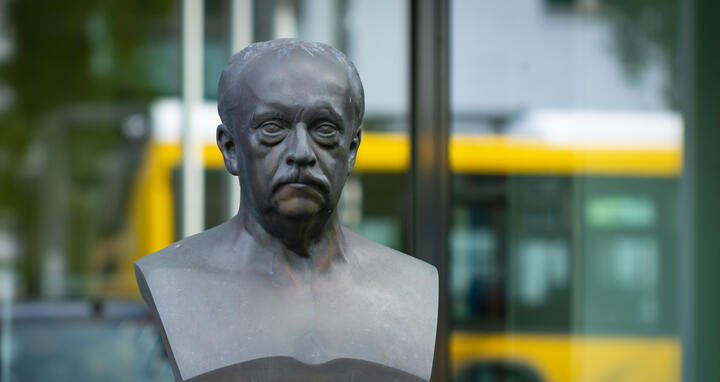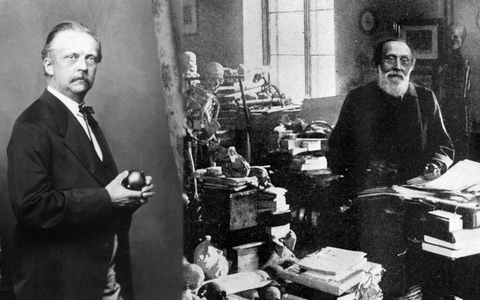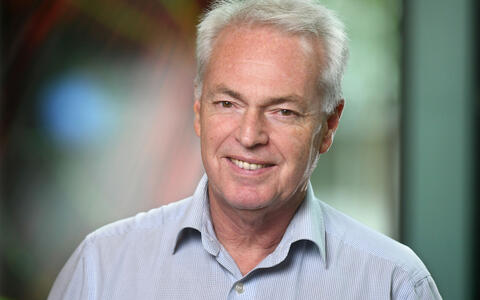Helmholtz, Virchow and Berlin's medical tradition
Rudolf Virchow realised that it was possible to diagnose diseases by looking at changes in cells, and his book "Cellular Pathology", published in 1858, was a milestone in the history of medicine. He was also an anthropologist, politician, public health expert and civic reformer.
Hermann von Helmholtz made his reputation as a physicist, for example with his law of conservation of energy, which states that energy can change from one form into another but the total energy always remains constant. He was also a polymath, working at the interface between physics and physiology but also in colour science, the perception of sound, and practical matters such as the development of the ophthalmoscope.
From antiquity to modern medicine
The work of both men is explored in detail in a newly published book by Detlev Ganten, the founding director of the MDC, in collaboration with Ernst Peter Fischer. In "Die Idee des Humanen. Rudolf Virchow und Hermann von Helmholtz. Das Erbe der Charité" [The Idea of the Human. Rudolf Virchow and Hermann von Helmholtz. The Heritage of the Charité], the authors place the work of both scientists in the context of research in Berlin today and show how it shaped our modern environment. This well-written introduction to the history of medicine looks back at the ancient world, describes the continual effort to achieve good health and the battle against disease, and brings us to the era of Helmholtz and Virchow, in which science and medicine thrived after the founding of Berlin's university. It ends with a look at the modern day, with prominent scientists Emmanuelle Charpentier and Christian Drosten.
Photomontage of Hermann von Helmholtz (left) and Rudolf Virchow (right)
Hermann von Helmholtz is known to most people as a physicist, and was even dubbed the 'Reichskanzler of physics' in allusion to his contemporary, chancellor Otto von Bismarck. What is often forgotten is the fact that he studied medicine and began his career as a medical scientist. In 1842, at the age of 21, he earned his doctorate with a thesis in the field of neuroscience. It was around this time that Christian Ehrenberg, a professor at the University of Berlin, published the first illustration of a nerve cell. During this same period, Jacob Henle and Matthias Schleiden formulated their cell theory in Berlin. According to this theory, all types of tissue, including the brain, are made of cells.
What leeches, earthworms and humans have in common
In his doctoral thesis, Hermann von Helmholtz examined the structure of the nervous system of invertebrates. Did it follow similar principles to that of vertebrates and humans, or was it quite different? Under the supervision of the most renowned anatomist and physiologist of the time, Johannes Müller, he studied the nervous system of leeches, house spiders, butterflies, earthworms, crayfish and freshwater mussels. He discovered that the nervous systems of these invertebrate animals did not fundamentally differ from those of vertebrates, including humans. All the basic elements, such as cells and their extensions, were identical: the structure of the nervous system seemed to follow the same plan throughout the animal kingdom.
The Latin curse: A pioneering but forgotten work
Prof. Helmut Kettenmann, author of the reading tip
These discoveries by Helmholtz have been forgotten by the neuroscience community today, because he wrote his thesis in Latin. Until recently, it had never been translated. Since my school Latin was not up to the task, I teamed up with classical scholar Julia Heideklang from the Humboldt-Universität and Joachim Pflüger, an invertebrate neurobiologist at the Freie Universität, to produce both an English and a German translation complete with detailed introduction and notes. In his doctoral thesis, Helmholtz formulated as a 21-year-old ideas that are still valid in modern neuroscience, providing early evidence of his exceptional – sometimes visionary – ability.
Our book has just been published by WBG Verlag.
We hope it will prove interesting to many readers and would love to hear your feedback.
Text: Helmut Kettenmann
- About the author
-
Further information →
-
Prof. Helmut Kettenmann is head of the Cellular Neuroscience research group at the MDC. To mark the 200th anniversary of Hermann von Helmholtz's birth on 31 August 2021, the neurobiologist has translated the famous polymath's dissertation from Latin into German and English and annotated it. His co-authors are Julia Heideklang, doctoral student at the DFG Gradute School and research associate at Humboldt University in Berlin, and Hans-Joachim Pflüger, Professor of Functional Neuroanatomy/Neurobiology at Freie Universität Berlin.
Helmut Kettenmann did his Abitur at the Helmholtz-Gymnasium in Heidelberg and then studied biology. His research focuses on glial cells of the brain. Glial cells and neurons are the basic elements of the nervous system. The distinction between these two cell types was established after the publication of Helmholtz's thesis by Rudolf Virchow. Virchow was a renowned physician, pathologist and politician. The 200th anniversary of his birth is also being celebrated this year.
The books
-
Ernst-Peter Fischer und Detlev Ganten, Die Idee des Humanen: Rudolf Virchow und Hermann von Helmholtz. Das Erbe der Charité. S. Hirzel Verlag GmbH2021.
-
Julia Heideklang, Hans-Joachim Pflüger, Helmut Kettenmann, De fabrica systematis nervosi evertebratorum: Die kommentierte Dissertation von / commented Thesis by Hermann Helmholtz, wbg Academic 2021.







